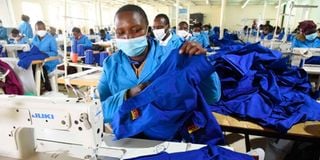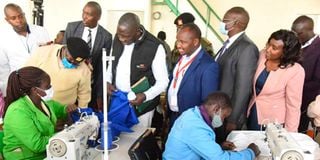Rivatex is operating below capacity despite massive funding

Workers at Rivatex East Africa Limited in Eldoret town, Uasin Gishu County making police uniforms during a visit by Government Spokesman Col. (rtd), Cyrus Oguna on June 21, 2022.
Eldoret-based textile manufacturer Rivatex is operating below capacity, despite the government and development partners pumping billions of shillings into its revival for the last two decades.
Inadequate raw materials and the high cost of labour and electricity are some of the factors slowing down the revival of the once vibrant textile firm that employed over 10,000 people.
On Tuesday, the company management admitted that it was operating below capacity due to a shortage of cotton, producing an average of 40,000 bales annually against a capacity of 200,000.
The firm is receiving 3,000 bales monthly against a capacity of 20,000, translating to heavy losses, said General Manager for Corporate Services Patrick Nyaga.
“Just like other textile firms in the country, the company is faced with a serious shortage of cotton and has to import raw material from East Africa Community member states,” disclosed Mr Nyaga during a tour of the firm by government spokesperson Col (rtd) Cyrus Oguna.

Government Spokesman Col. (rtd), Cyrus Oguna (centre), during a visit at Rivatex East Africa Limited in Eldoret town, Uasin Gishu County on June 21, 2022.
Demand deficit
Kenya produces an average of 5,300 tonnes of lint monthly against demand of about 38,000, with the deficit filled by imports from neighbouring countries.
Mr Nyaga said the textile firm is expected to increase cotton consumption from 10,000 bales per day against a projected capacity of 100,000, translating to a daily production rate of 40,000 metres, up from the previous 5,000.
It requires more than 500,000 acres of cotton to realise steady supply of raw materials to support smooth operations.
“We do not have sufficient Bt cotton seeds in the market, which means we are recycling the conventional seeds, which translates to low productivity,” said Mr Nyaga, adding that the company has entered into a partnership with counties in the region to boost supply of the raw materials.
“Although we have invested in Bt cotton, the production is insufficient to support our operations,” added Mr Nyaga.
He disclosed that acreage under Bt production increased from 33,193 to 149,000, but production remained at 10,000 bales annually, which is too low to sustain the operations of textile firms in the country.
“The production is like a drop in the sea considering that the demand outstrips supply to many textile firms in the country,” he said.
Imports
The county produces an average of 5,300 tonnes of cotton against demand of about 38,000, with the deficit worth about Sh17 billion being imported from neighbouring countries.
It recently injected Sh650 million for modernising New Rivatex with financial support from development partners.
“The government is committed to fast-trucking the modernisation of Rivatex [and] expanding job creation ...,” Mr Oguna said during his Tuesday tour.
New Rivatex secured a Sh3 billion loan last year from the Indian government and an additional Sh3 billion from the National Treasury to replace its obsolete machines.
In the 2019-2020 budget, the firm was allocated Sh1.1 billion.
Receivership
The textile firm was bought by Moi University for Sh205 million after it was placed under receivership more than 10 years ago.
It was placed under receivership in 2000 following massive administration and financial mismanagement.
According to Mr Nyaga, the Bt cotton variety, which is resistant to ball worm pests, is in trial in traditional cotton-growing regions and it will help boost availability of fabrics for textile manufacturing firms.
“The trial for cultivation of Bt cotton is ongoing in six counties – Busia, Baringo, Tana River, Kirinyaga, Makueni and Meru – and once ratified will guarantee steady supply of raw materials to textile manufacturers,” Mr Nyaga said.
The county imports fabrics worth Sh17 billion annually to Athi River-based EPZ manufacturers.
The North Rift region produced 852.60 tonnes of cotton on 794.5 hectares last season.





